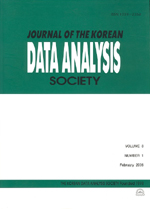Analysis of Financial Time Series Using Integer-Valued GARCH Models
- 한국자료분석학회
- Journal of The Korean Data Analysis Society (JKDAS)
- Vol.15 No.2
-
2013.04593 - 602 (10 pages)
- 2

There has been a considerable and growing interest in integer-valued time series data leading to a diversification of modelling approaches. Among them, we focus two recent models. The first model is the INGARCH(p,q) model proposed by Ferland et al. (2006) which is able to describe integer-valued processes with overdispersion and analogous to classical generalized autoregressive conditional heteroskedastic (GARCH) (p,q) model. And the second model is a special class of observation-driven models termed integer-valued autoregressive processes introduced independently by Al-Osh, Alzaid (1987) and McKenzie (1988), which is extended to higher orders by Du, Li (1991). The INAR(p) models use thinning operations, not scalar multiplication in AR(p) model. Therefore the implementation of ML in INAR(p) model is not ease, fortunately, Bu et al. (2008) developed a general framework for maximum likelihood (ML) analysis of higher-order integer-valued autoregressive processes. In this paper, we summarize some characteristics of INGARCH(p,q) model. And we analyze real data example for Korean financial time series using the INGARCH(p,q) model and INAR(p) model.
1. Introduction
2. Reviews of the INGARCH models
3. Maximum likelihood estimation of INAR(p) model
4. Application
5. Conclusion
References
(0)
(0)